SEO
5 SEO Insights to Learn From
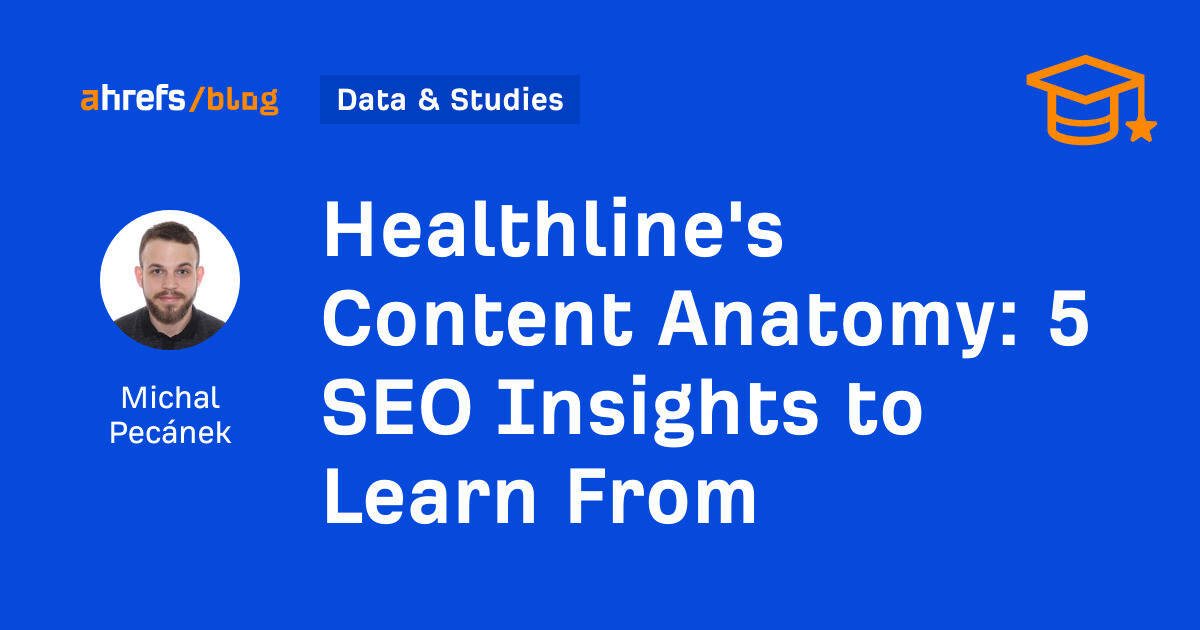
Healthline is one of the biggest health niche websites. We’re talking tens, if not hundreds of millions of clicks every month with fierce competition. It doesn’t get much more exciting in SEO than this.
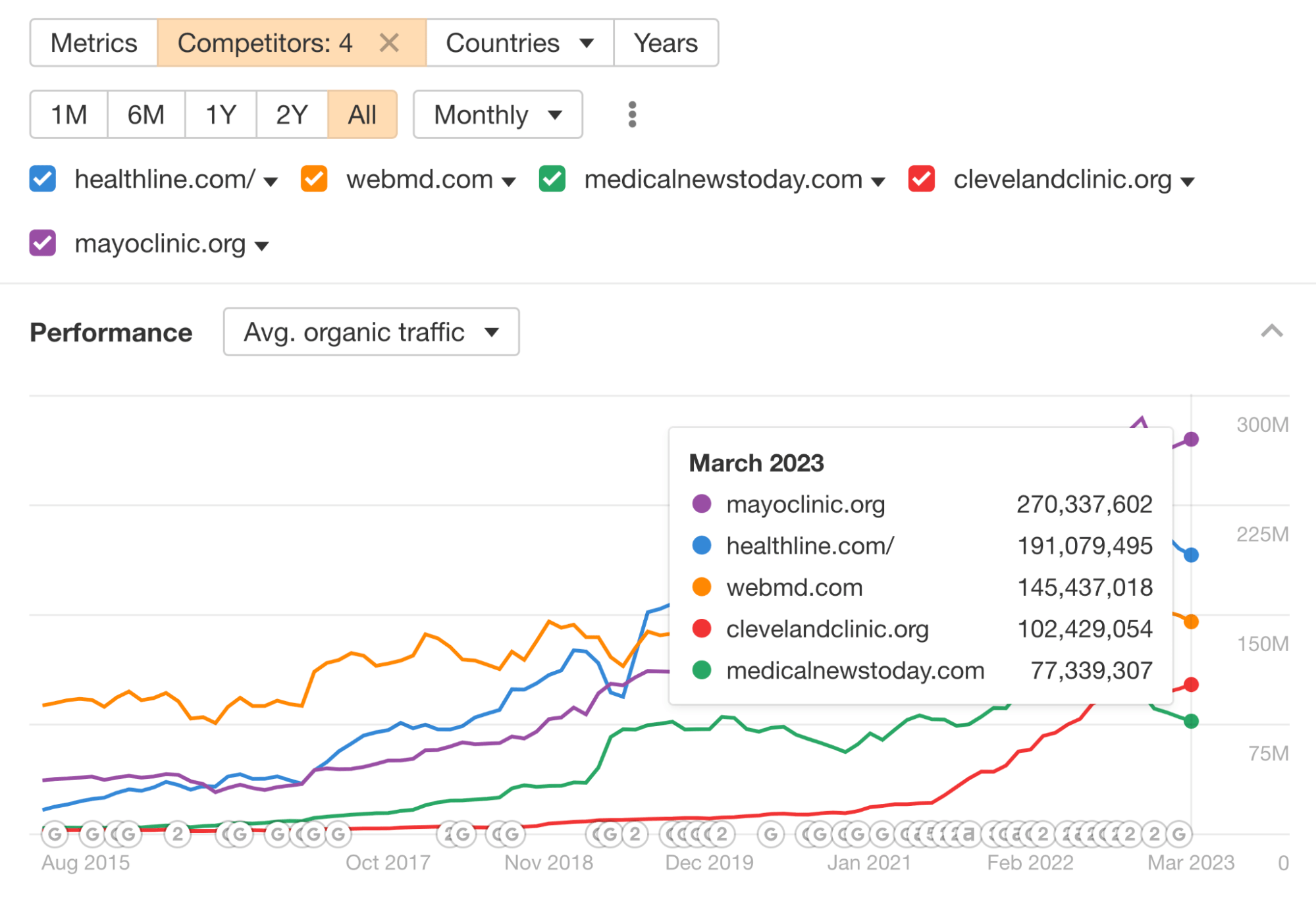
Healthline is owned by media giant company Red Ventures, which has a whole RVO Health subdivision comprising many domains in this YMYL niche. One of them is also Medical News Today that you can see among the biggest players listed in the chart above.
All of these websites are SEO powerhouses we can learn from, but I found Healthline to be the most interesting one, especially its content and on-page aspects. Let’s take a look at five insights that stood out to me from many hours of analysis.
It’s hardly a surprise that you’ll find patterns after publishing tens of thousands of pieces of content. In Healthline’s case, it currently has around 34K pages in its Health and Nutrition article subfolders that drive the vast majority of its traffic:
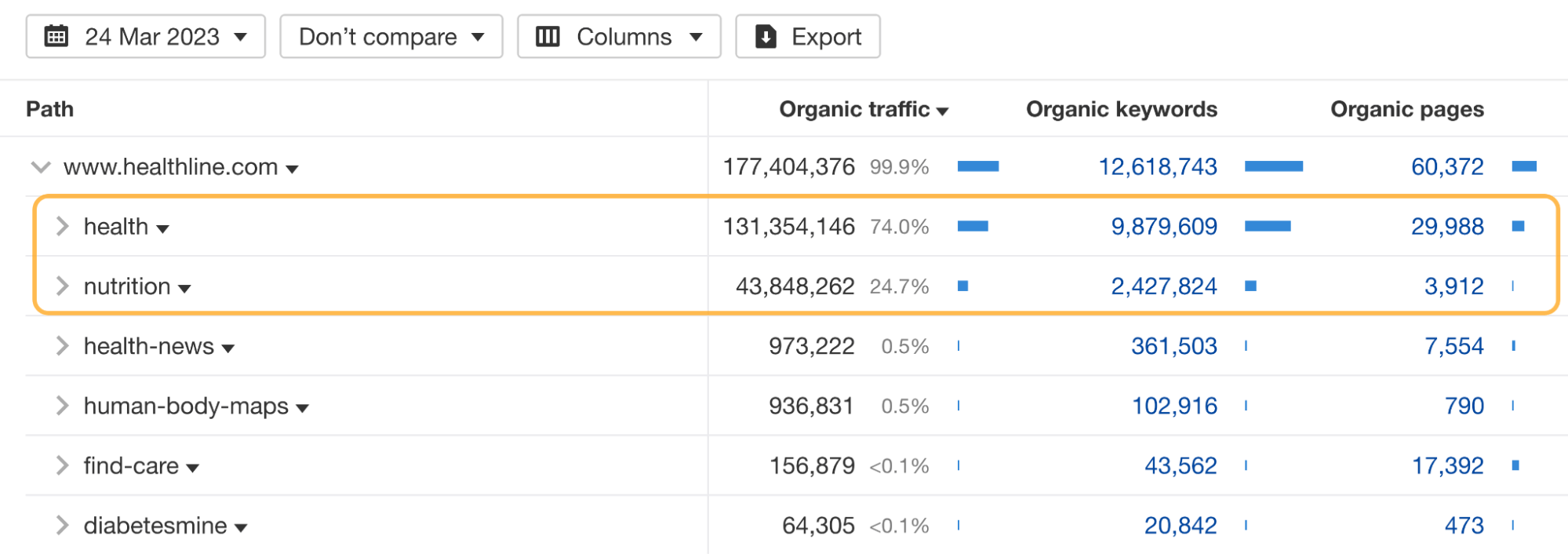
Certain types of content, like food item overviews, can be templated pretty heavily, as you can see from the title tags and H2s here:
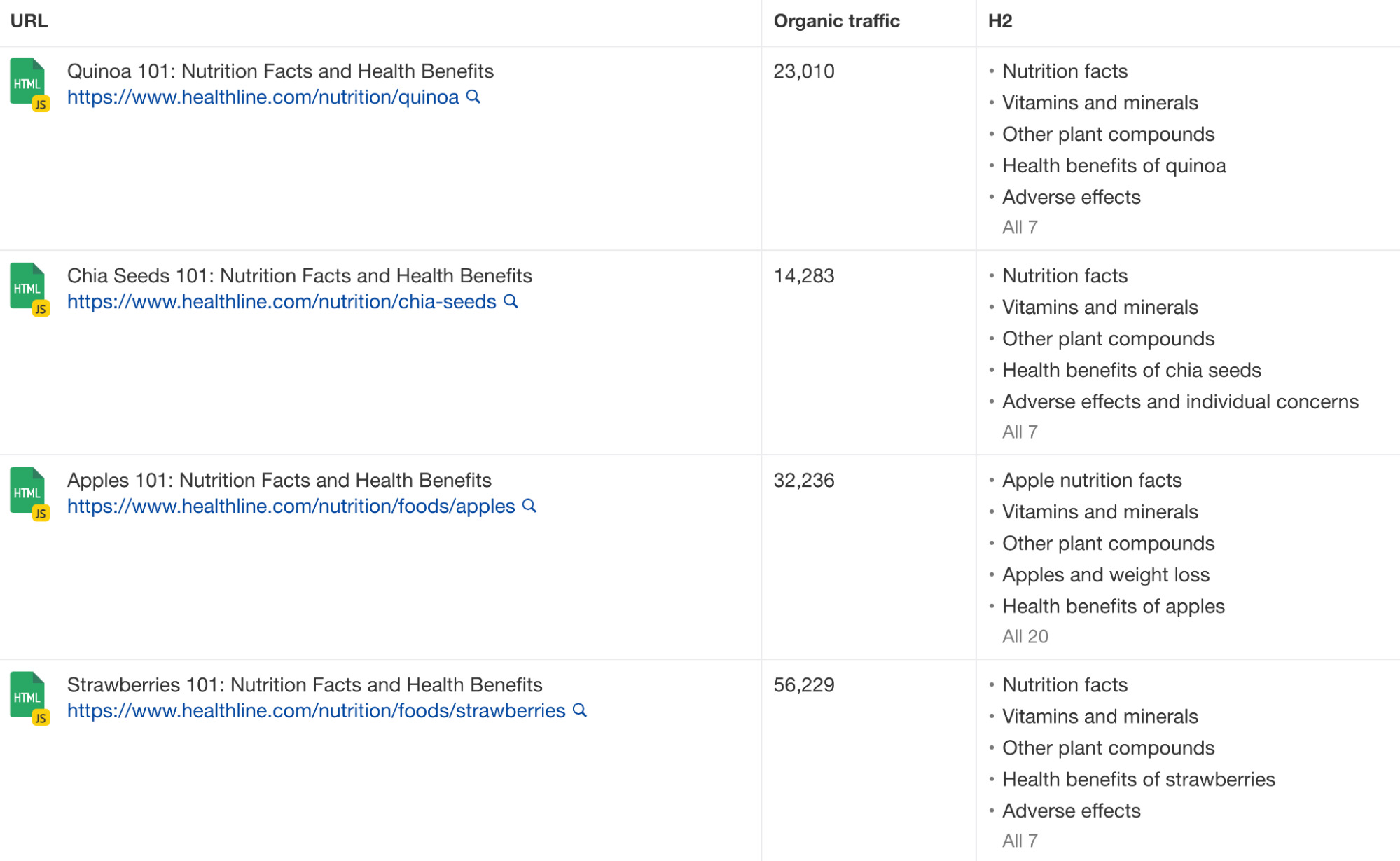
But more often than not, you’ll need some more unique points and headings to align perfectly with the search intent.
For example, here are three SERP snippets that use the same title tag template that tells you the focus of the article.
We have crackling in ear…

Followed by wrist pain…

And ending with contact dermatitis.

Causes, symptoms, and treatment are variables the vast majority of searchers will be interested in when looking up these health problems.
But crackling in ear can be something you may be able to fix easily with home remedies:
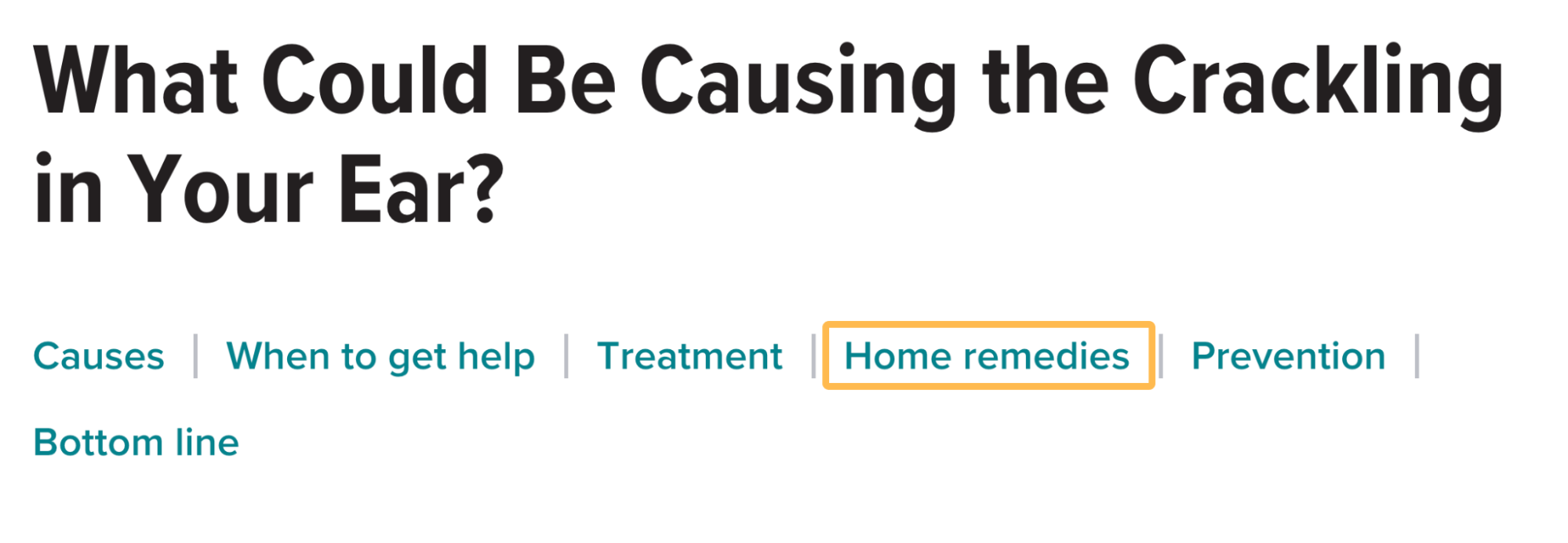
Wrist pain usually requires you to do some exercises to get better:

And contact dermatitis is something you likely need to see photos of to confirm if you landed on the right health problem:

All of these articles have huge structural overlaps but are still unique in one way or another, which makes them great for answering all sorts of questions a searcher may have.
Healthline uses the title template of {health problem} followed by the most relevant combination of words like causes, symptoms, treatment, diagnosis, risks, preventions, pictures, etc., across the board.
It sounds simple. But choosing the right combination that best aligns with the search intent results in SERP titles that are better—or at least on par with the competition:

And this goes on and on throughout different content types. Here, we have a bunch of pages where people are likely most interested in the difference:

While others are positioned toward picking a winner for a certain quality (better, healthier, etc.):
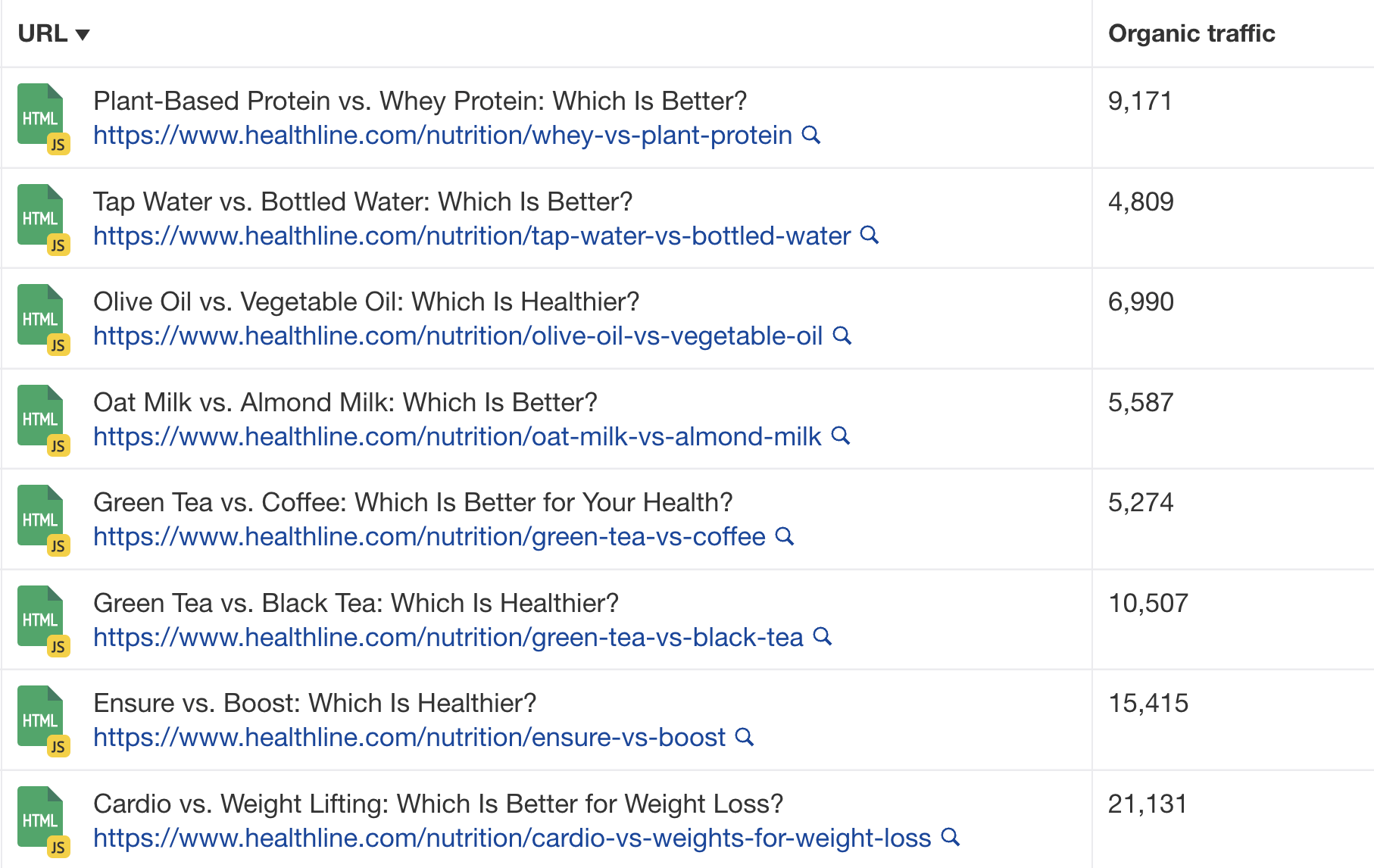
Nailing search intent alignment is one thing. But being able to do it with multiple pieces of content that have huge target keyword overlaps is an advanced SEO and content game.
I think most people associate ranking for one keyword using multiple pieces of content with a phenomenon that hurts one or more of these pages. This is known as keyword cannibalization.
But take a look at this:

As someone who’s done a bit of research about creatine in the past, I can see myself clicking on both of these results. They cover the topic from different angles that don’t result in cannibalizing each other’s organic traffic.
Anyway, you can’t even cannibalize your own content when you already rank at the top with one of those pages. Occupying more search results simply gets you more traffic.
There are currently over 40K keywords in the U.S. where Healthline owns the top SERP position and one or more lower positions:
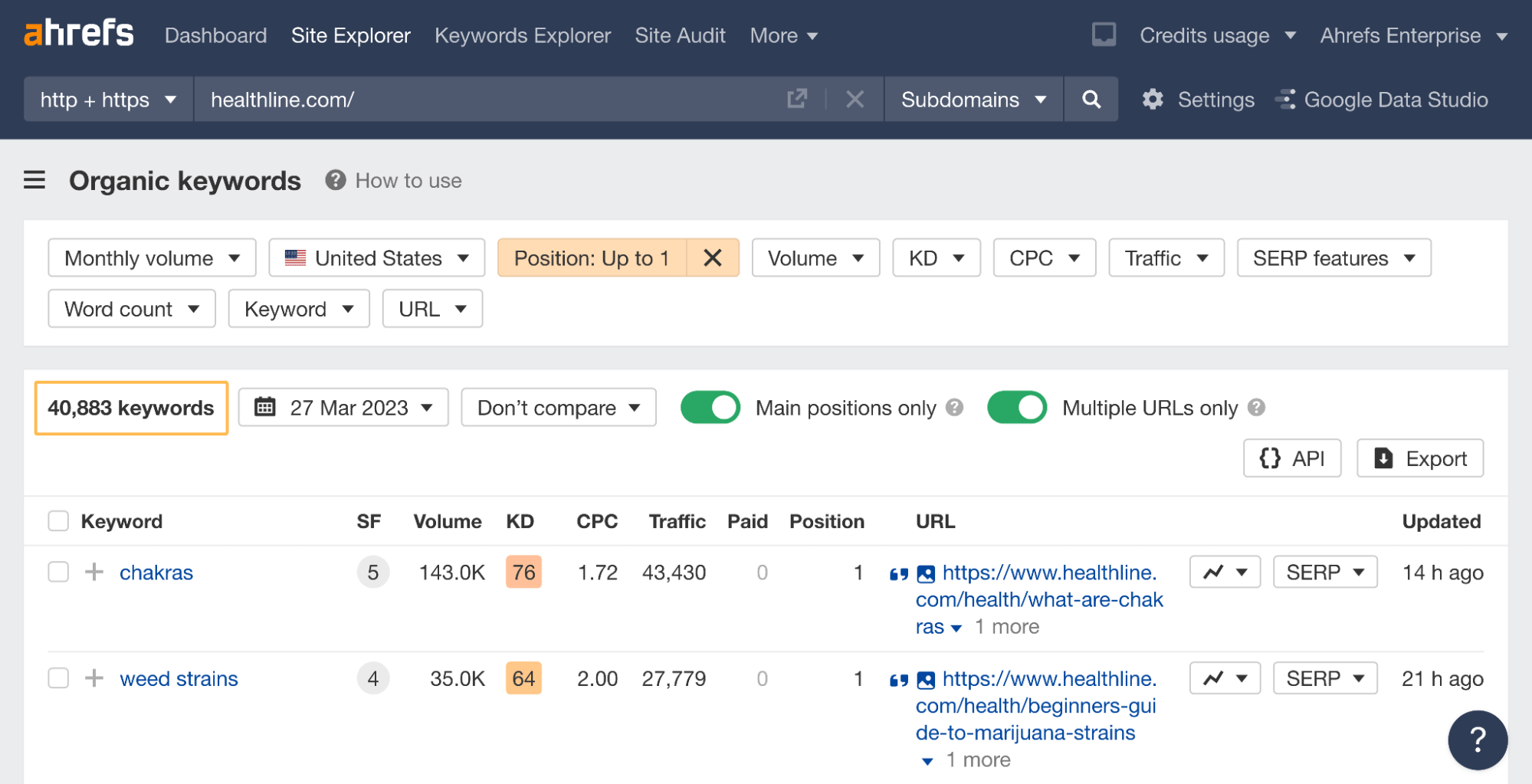
Not all of these keywords have a mixed search intent, though.
In some of these cases, Healthline likely ranks with more pieces of content that serve the same purpose just because it is a huge authority in the space. I didn’t encounter this from examining many of its SERPs. But the following data speaks for itself.
What surprised me the most is the fact that out of the 1K keywords with the highest search volume here, it manages to rank for 994 of them with two or more results in the top 10 search results:
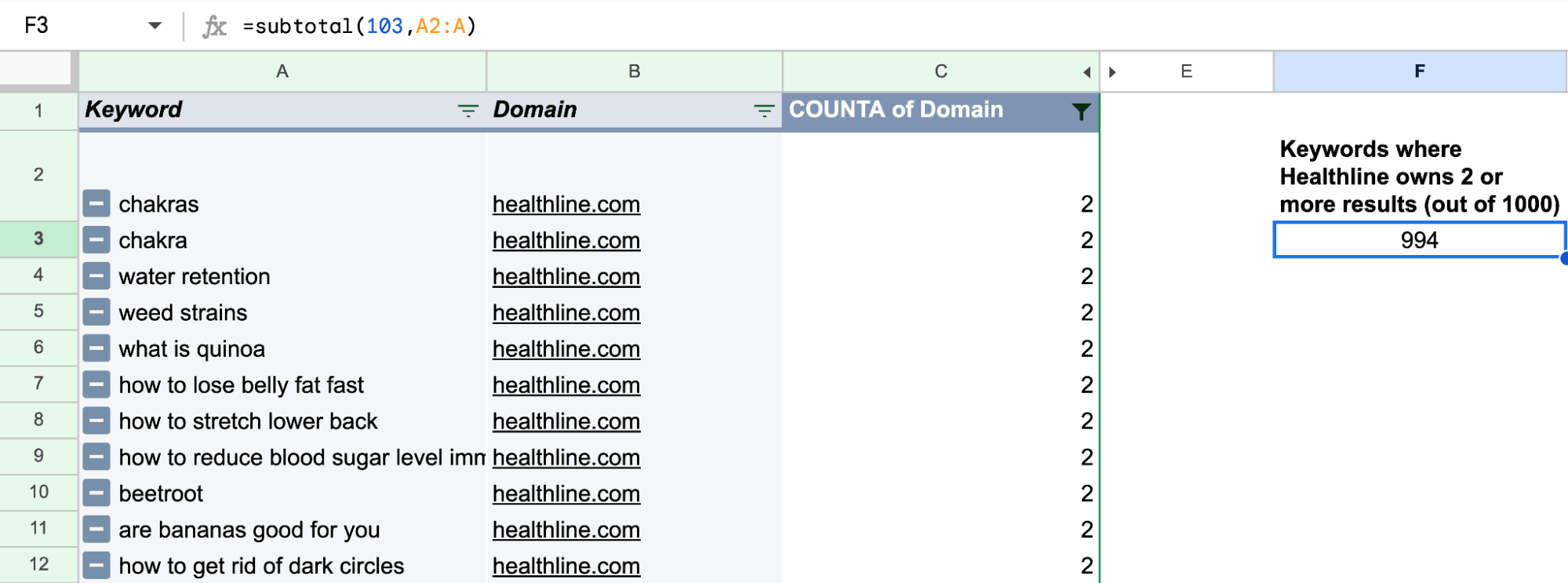
Last but not least, another way of taking more SERP estate is to rank with both written content and videos. You guessed it. Healthline also has a thriving YouTube channel, and it manages to own multiple results in this manner as well:
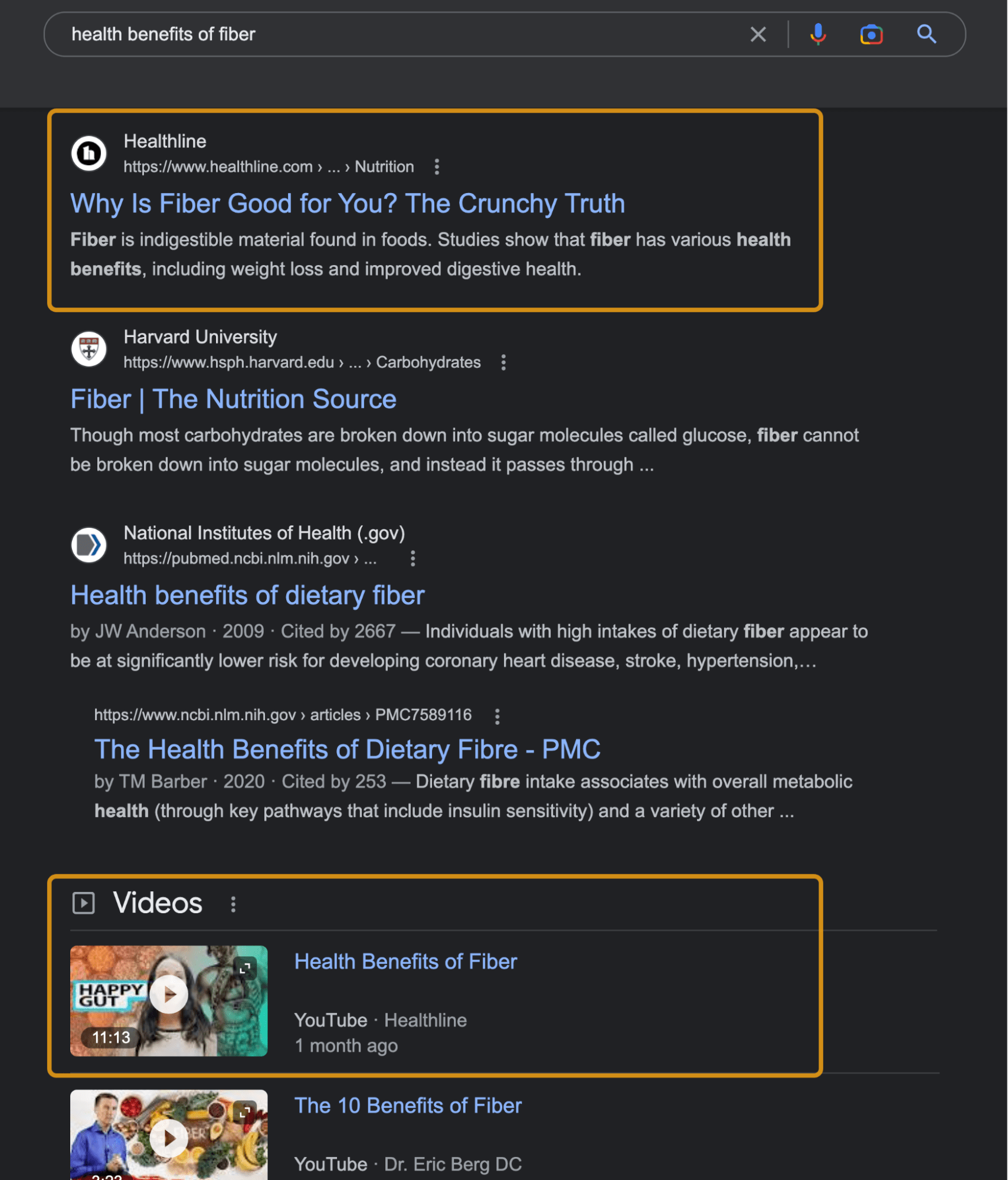
Two confessions: I hate the UX of most websites with display ads, and I often refer to engagement metrics like bounce rate as vanity metrics.
Yet I find the experience of browsing through Healthline smooth, with many nudges to keep me engaged with it longer. And I’m sure its team does a great job of doing visitor engagement analysis and goal setting.
There are three aspects worth taking a closer look at because SEO and UX are closely intertwined disciplines.
Keeping ads in moderation
Display ads, pop-ups, and interstitials are usually a nightmare for many browsing experiences without an ad blocker. (Are you really a marketer if you’re using one?)
Healthline seems to have found a great balance between monetization and user experience. Especially on desktop, it doesn’t stuff ads in between paragraphs, which I highly appreciate. I don’t mind seeing the ads at the top of the content or on the side:
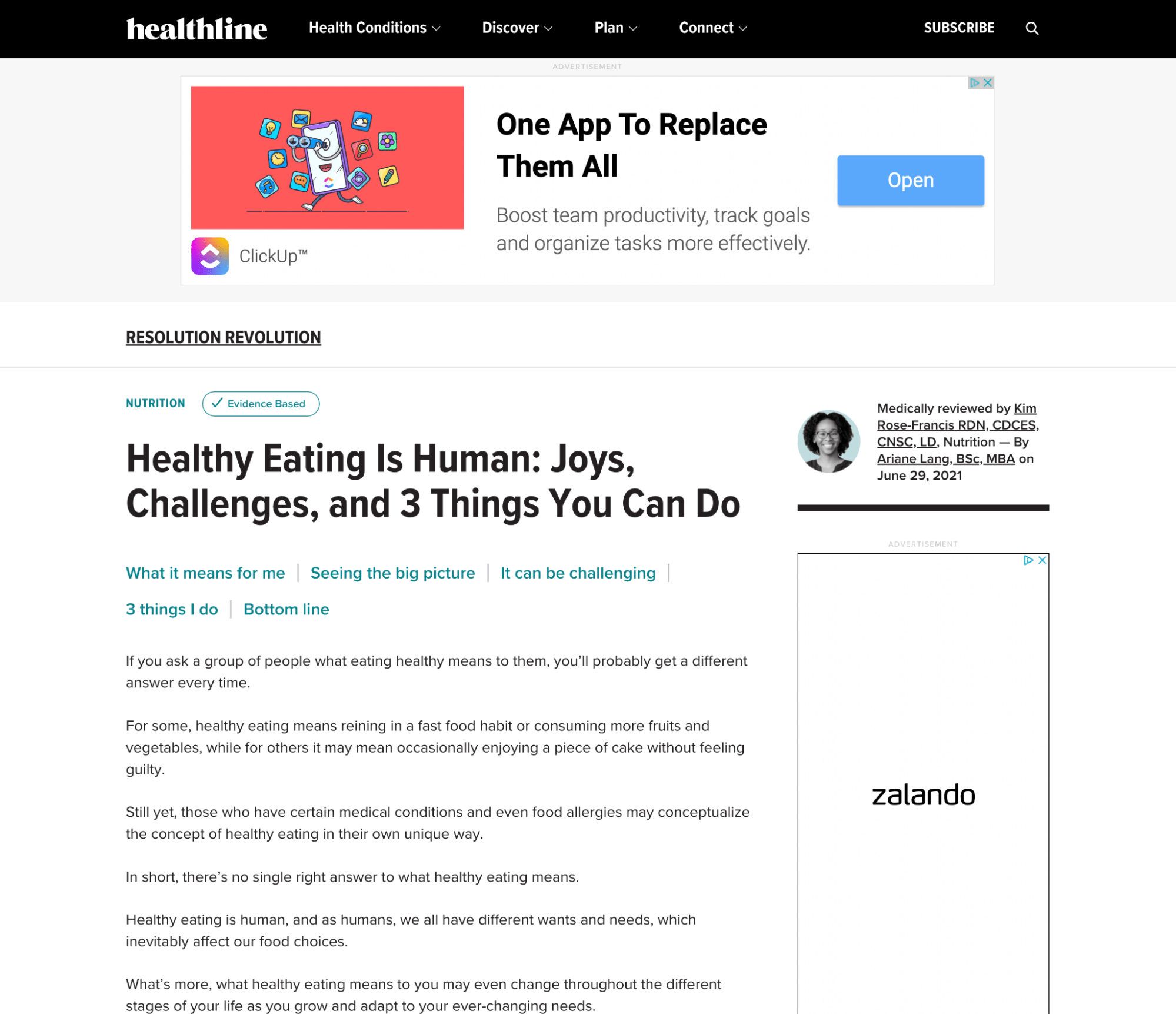
The experience obviously gets worse on mobile, as there is no sidebar. But the ads within the content still aren’t overwhelming. It also applies to pop-ups, as I only recall getting one for an email newsletter subscription, which is totally OK from time to time.
Infinite scrolling
A lot of Healthline articles use an infinite scroll feature where you seamlessly “flow” into reading another article related to the one you landed on. The URL changes as you go along.
For example, here’s an ending of a Beetroot 101 article that flows into the health benefits of beets with an ad in between:

I got into reading some Healthline articles and sometimes didn’t even realize that I was already reading another piece of content. It nails down the relevance, making the reader stay on the page longer, which naturally results in more monetization opportunities.
Chances are that it’s also a positive SEO signal, but we’re getting into speculations here. No one officially confirmed signals like dwell time to be a ranking factor.
Truly related content suggestions
The key factor in keeping readers engaged with more content is the relevance of the suggestions. We already showed an example of infinite scroll, but Healthline also employs other content suggestion methods.
There’s a well-known “related reading,” or as Healthline titles it, “read this next” section. For example, these are suggestions at the end of an article with the title “Healthy Eating Is Human: Joys, Challenges, and 3 Things You Can Do”:
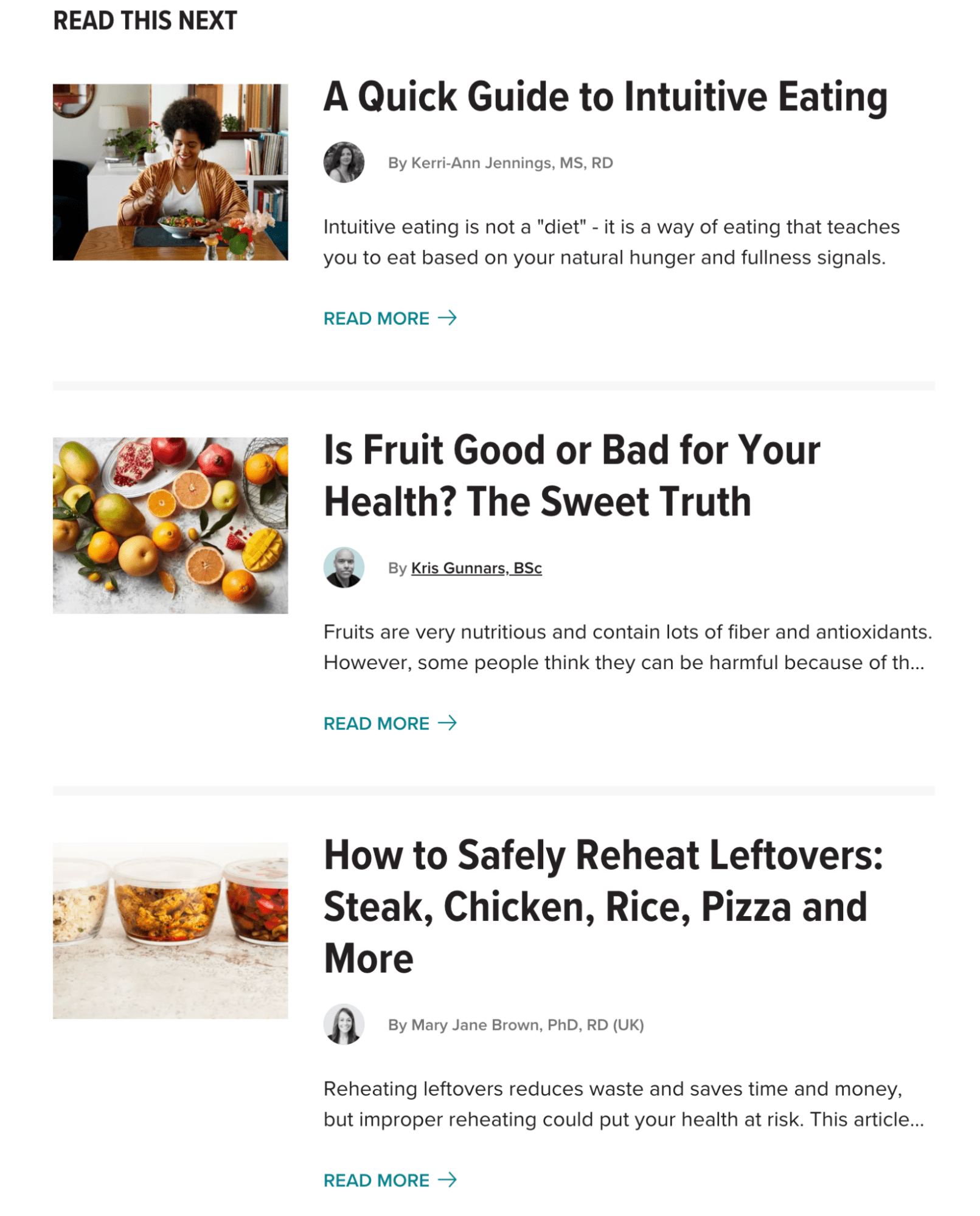
Looks good to me. What also looks good are its “related videos” sections to provide content in different formats, like this one in between the list of the “healthiest vegetables around”:
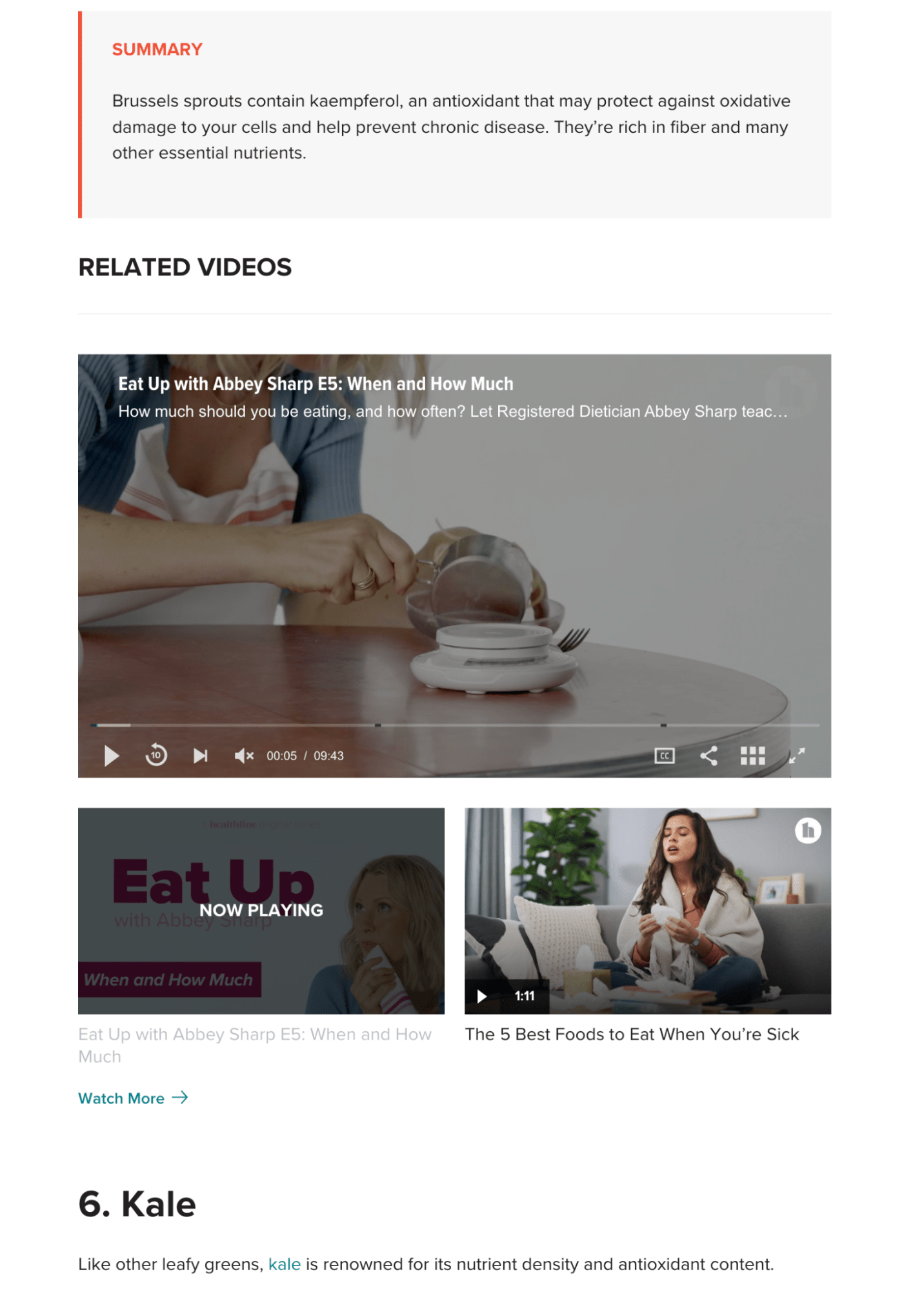
Being able to show video ads in there is just the cherry on the top.
The great relevance of all the suggested articles and videos we just covered makes me wonder how Healthline manages to do that. It’s unlikely that it selects these manually at this scale.
I encountered what seems to be a multi-level system of content tagging that could play a big role in creating this content recommendation system.
Healthline uses a combination of different meta tags, like on this page about losing weight:
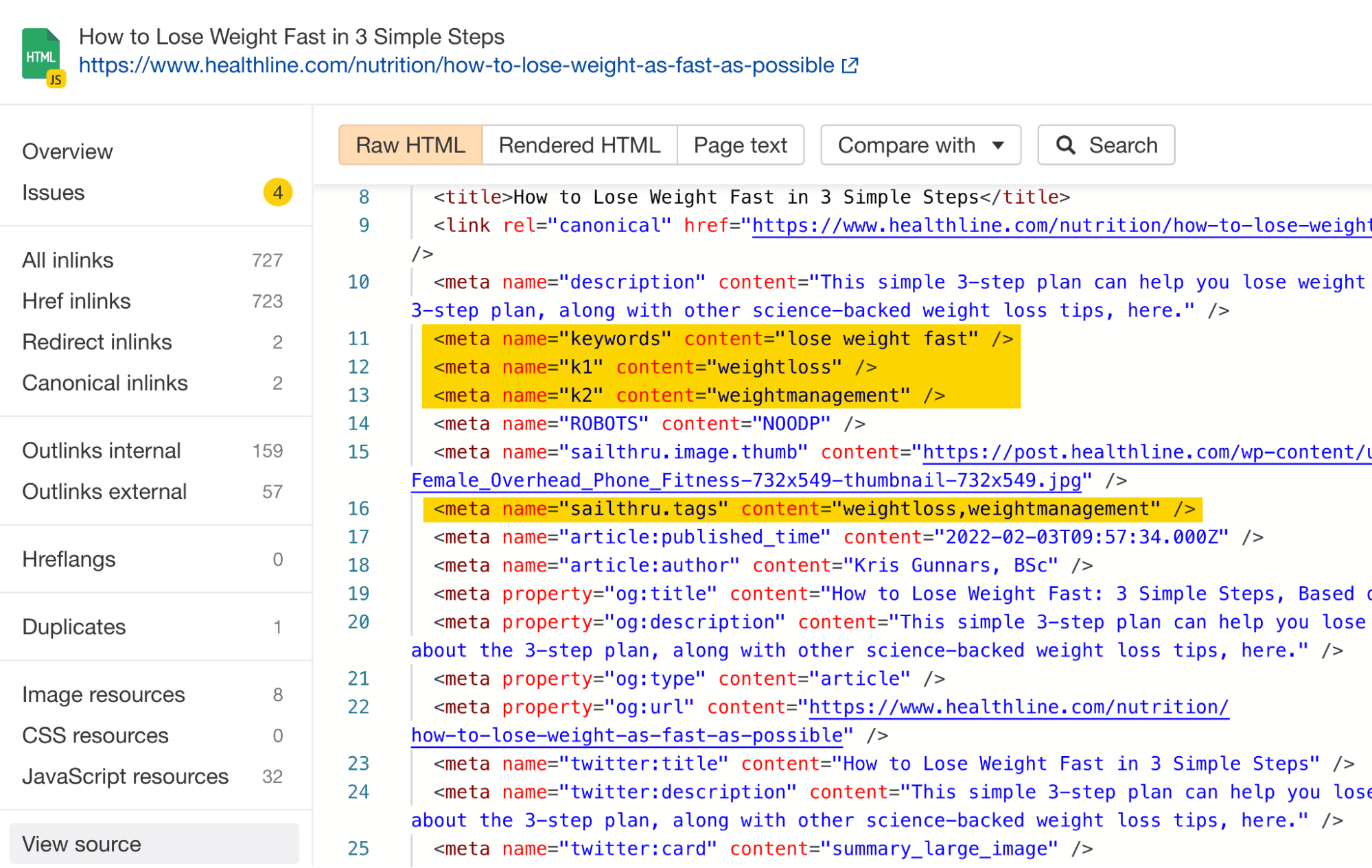
Yes, the long-dead meta keywords can still be encountered. While they don’t play any role in rankings (at least not for Google), they can come in handy for tagging the topics of each piece of content to create an internal topical hierarchy. Some advanced CMSes (like the headless ones) recommend doing it for this purpose too.
The sailthru.tags is a meta tag for categorization and user interest tracking used for a personalization engine. Healthline takes catering to search intent and users’ interests very seriously.
I made an assumption that it’s also serious about engagement tracking and goal setting. Well, there are lots of custom dimensions it sends to its Google Analytics, including these content tags:
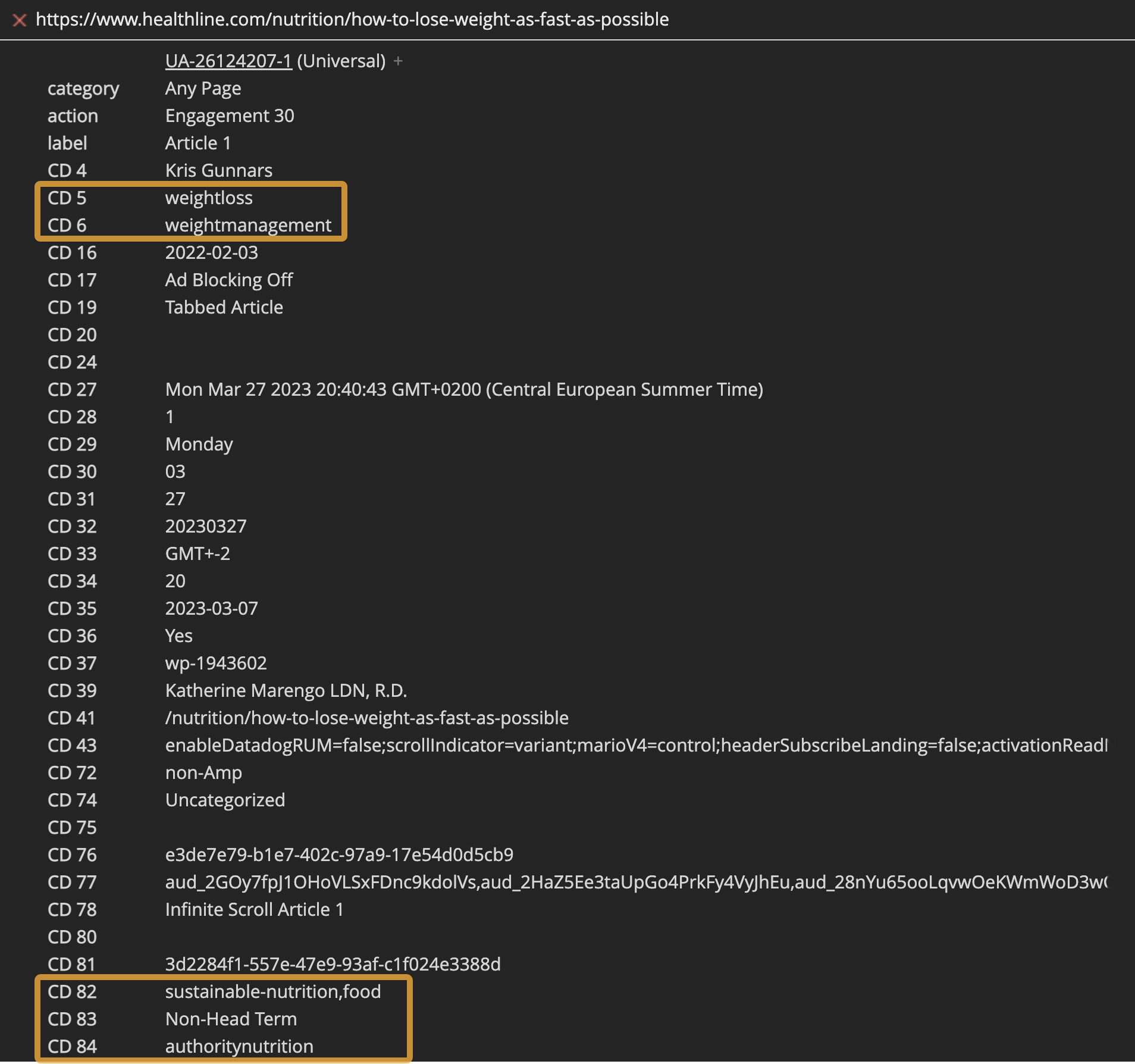
It will hardly surprise anyone that a successful website with 100% YMYL content excels in signaling E-E-A-T. But there are many aspects of this worth bringing up.
Most relevant authors and reviewers
It should go without saying that your authors should be qualified to cover their assigned topics, especially in YMYL niches. Healthline does a great job here.
It has a team of in-house writers and guest freelancers with various qualifications related to health and medicine. These people don’t necessarily need to be experts in a certain topic, but their backgrounds ensure that they can put together great content:
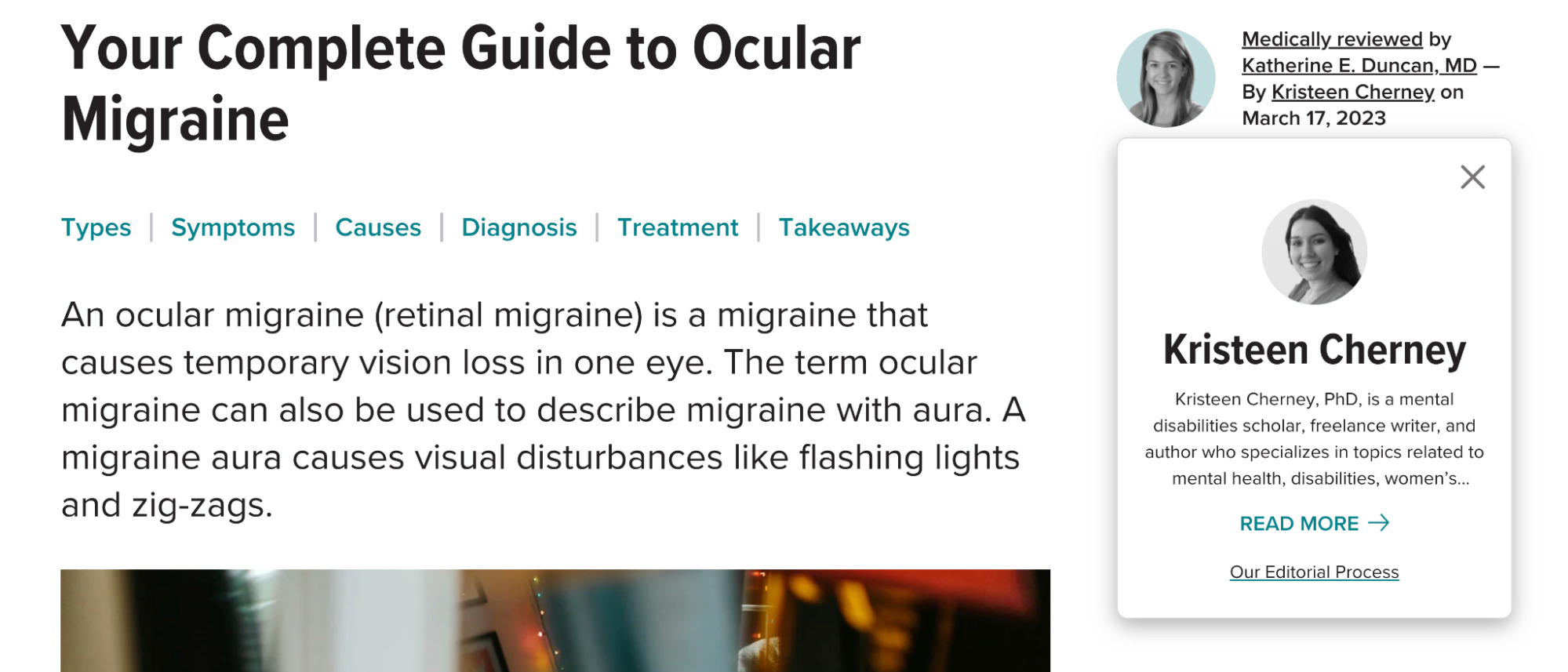
Then the experts come into play in the medical review. In this example, there’s no one more qualified for the job than an ophthalmologist:

Healthline’s medical team consists of four divisions that create a huge professional network with expertise for likely any medical topic you can think of:

Awards, accomplishments, citations, and backlinks of authors and reviewers
We have all encountered a few doctors that left us wondering how they even finished med school. Having a diploma is simply just a prerequisite. Given that E-E-A-T is largely about backlinks and references, it’s likely a good idea to get people with a successful track record.
Everyone I clicked on on Healthline seems to have great professional backgrounds and credentials:
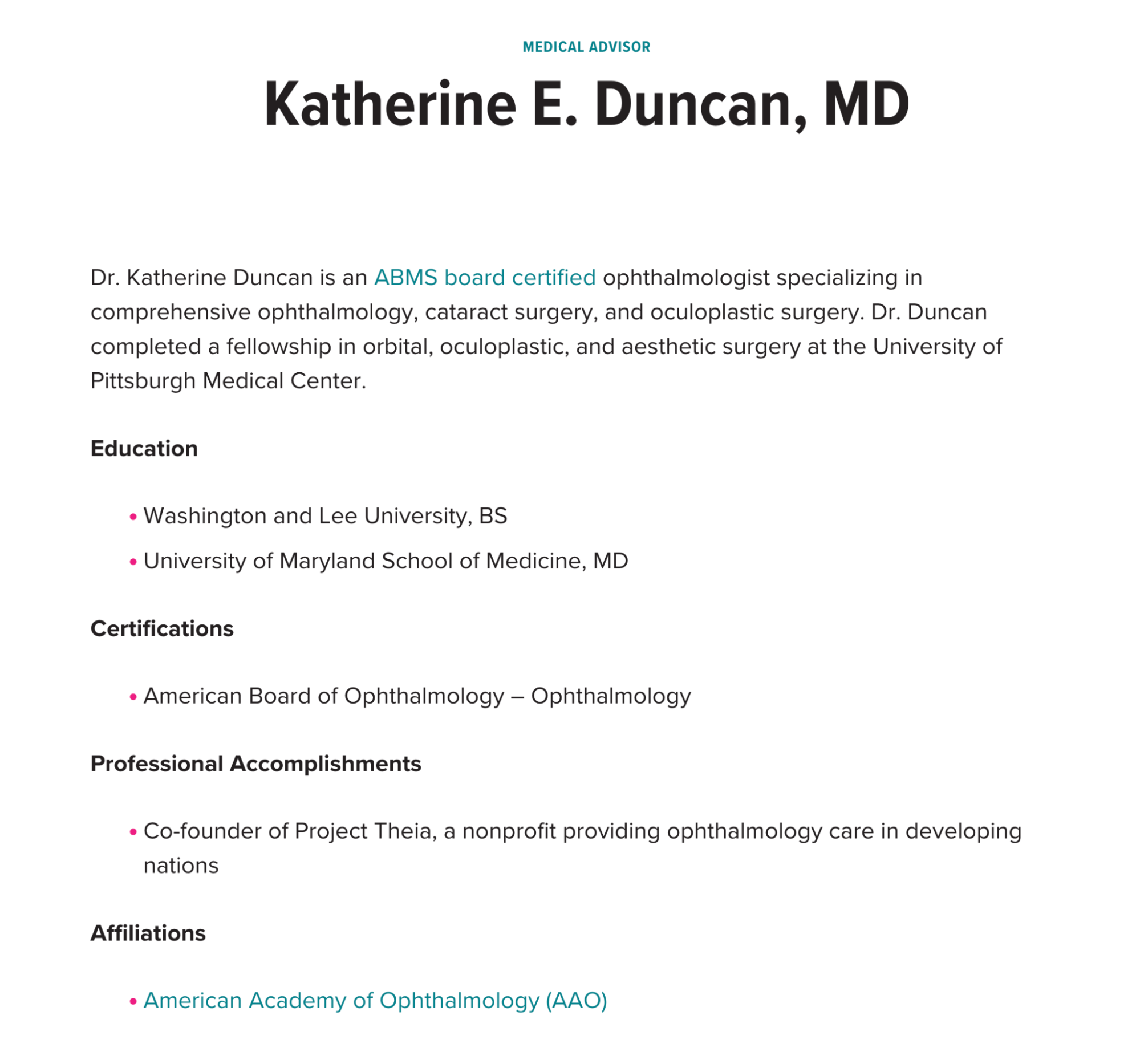
Diving into stuff like h-index or other author-level metrics seemed like an overkill here, so I at least looked up a few authors and reviewers in Google Scholar. Almost everyone returned relevant papers and articles from the Scholar index.
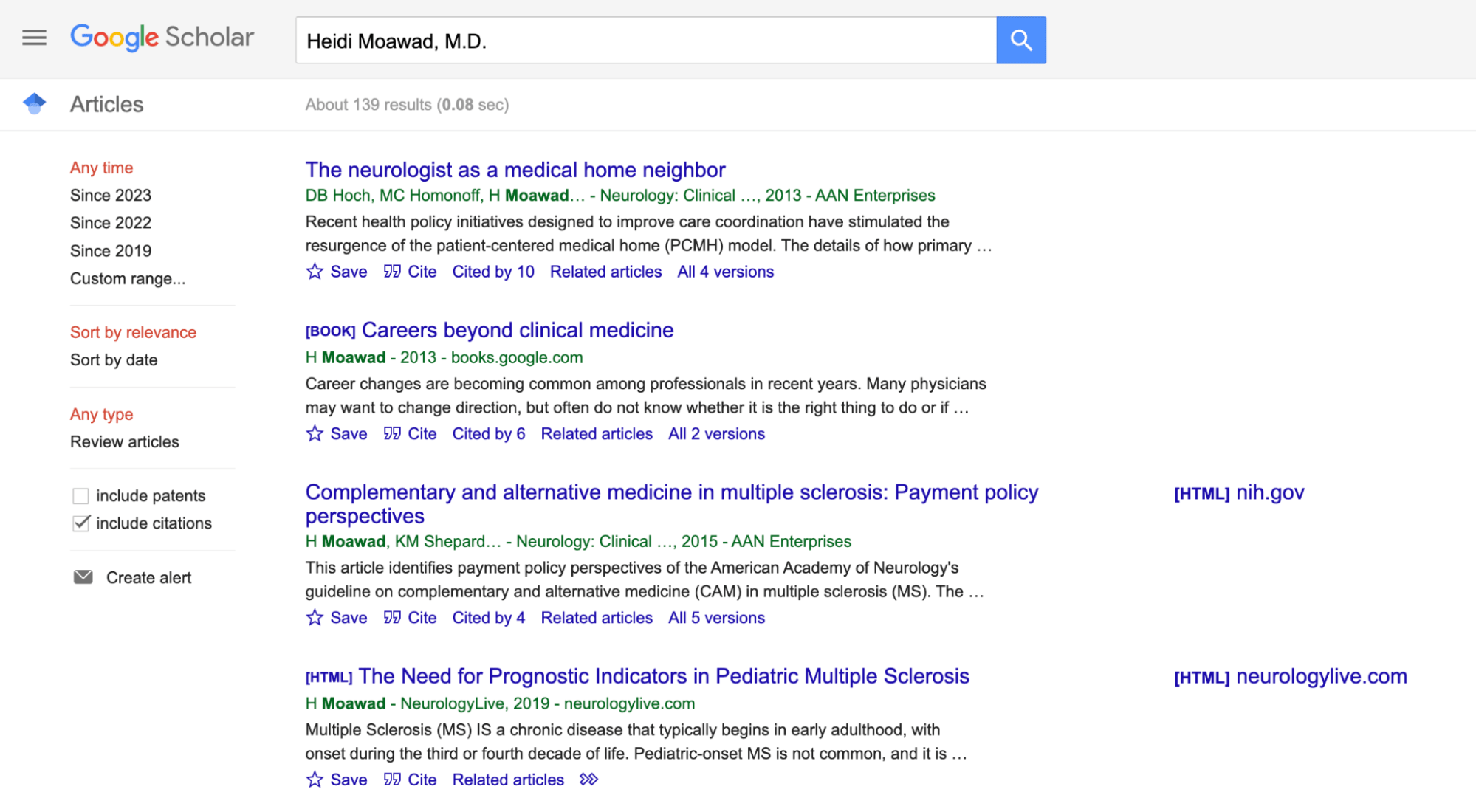
All of these things in academia are basically like backlinks in SEO. I won’t be surprised if all the data we’re showing here was interconnected on the entity level and that Google took it into consideration not only for enhancing the Knowledge Graph but also for rankings.
Speculations aside, Healthline already has all the highly authoritative backlinks that are so needed in this niche. We all expect that. But I took a look at a few personal websites from the Healthline’s editorial team and found some nice backlink profiles that signal E-E-A-T too:
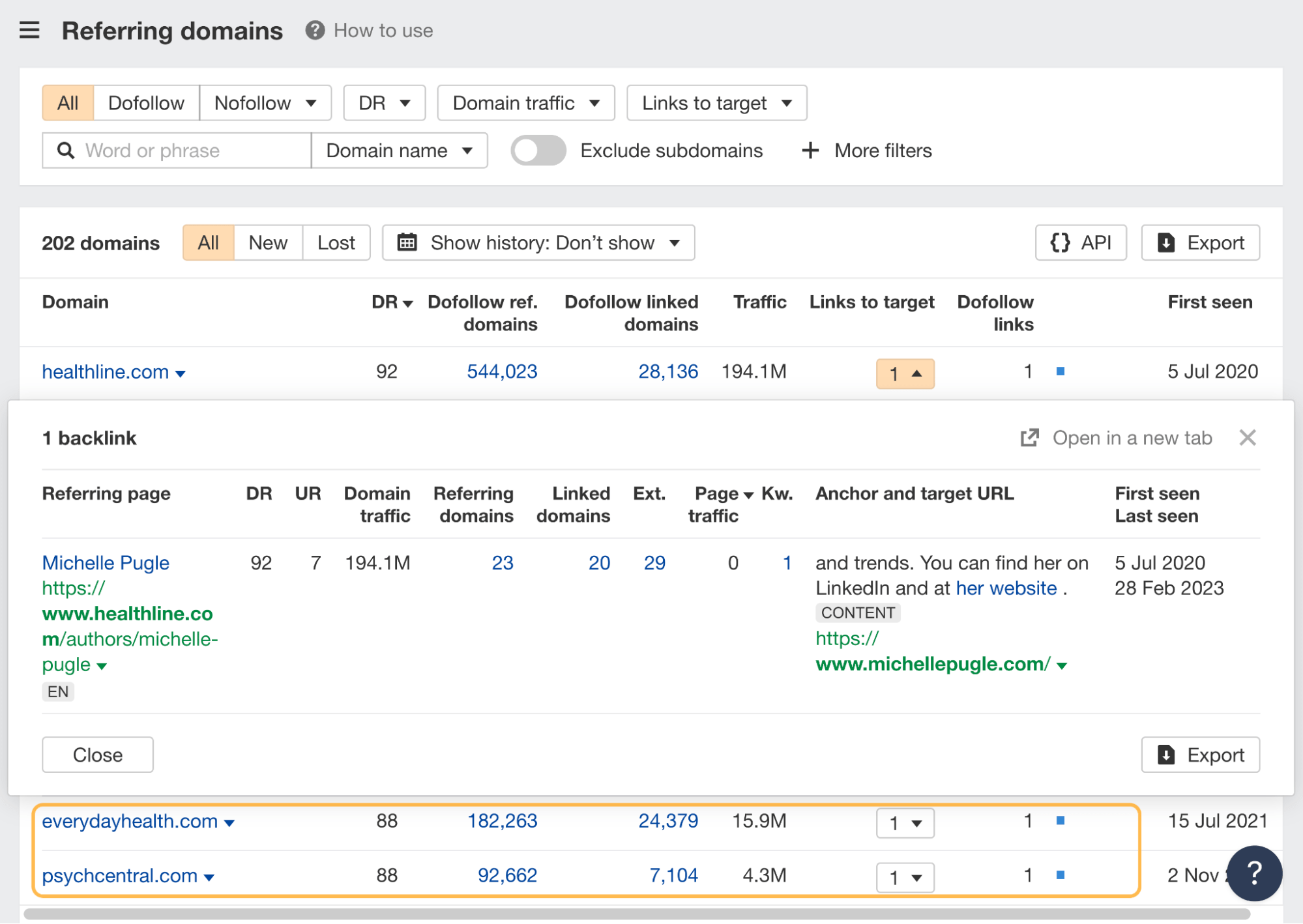
The takeaway is that the direct backlink profile is undoubtedly most important, but you can’t go wrong featuring great content from someone who already has a proven track record.
Meticulously describing editorial processes
Healthline has the most detailed and open documentation about its editorial processes, monetization, product selection, integrity, etc., that I’ve ever seen.
You can access all of this from its About page with a click or two.
For example, here’s an excerpt from its “product selection process” page that clearly signals the trustworthiness of its recommendations:
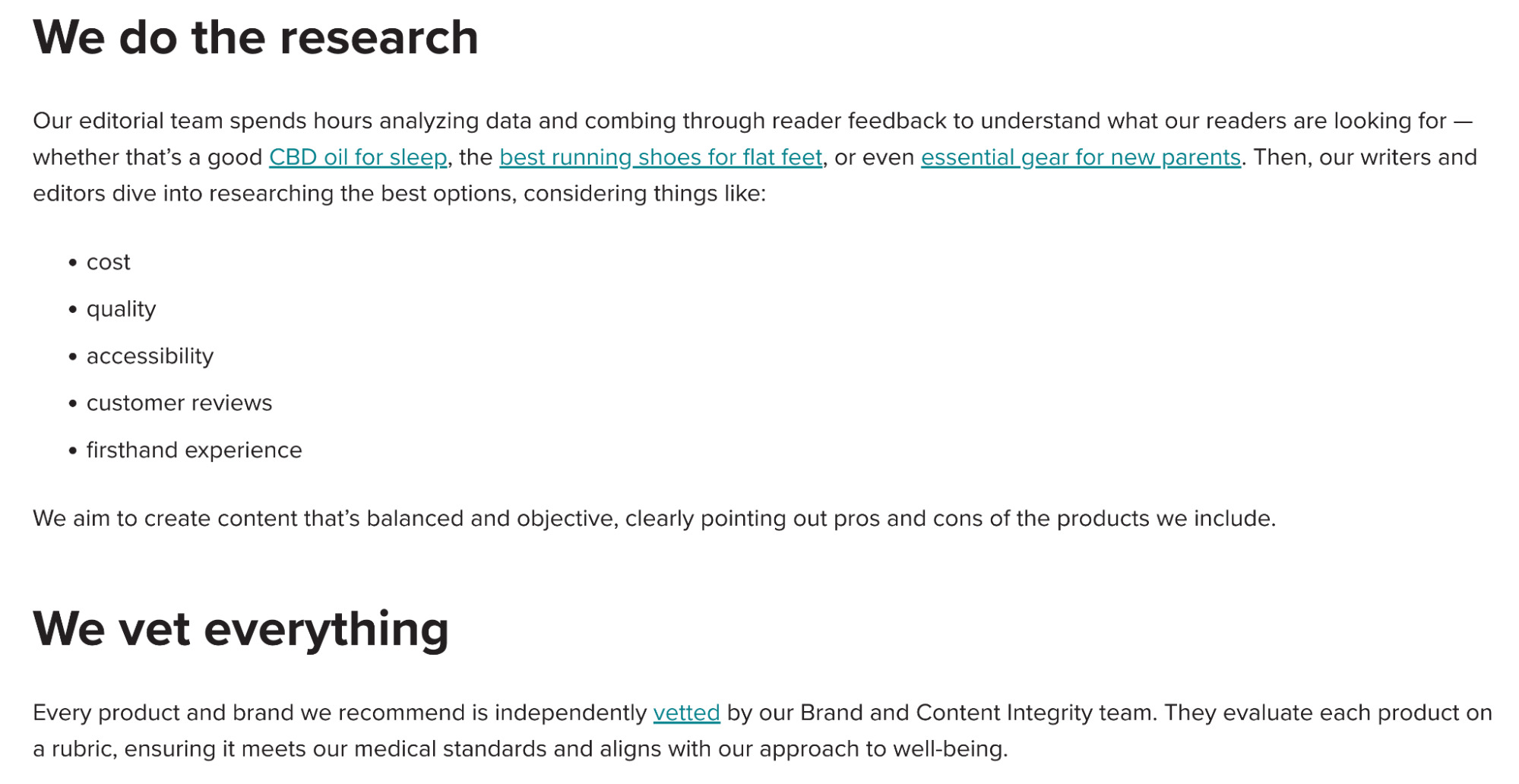
Adding a list of sources and references
Listing your sources is a great way to show the reader that the content is based on trustworthy information. Healthline includes those at the end of articles:
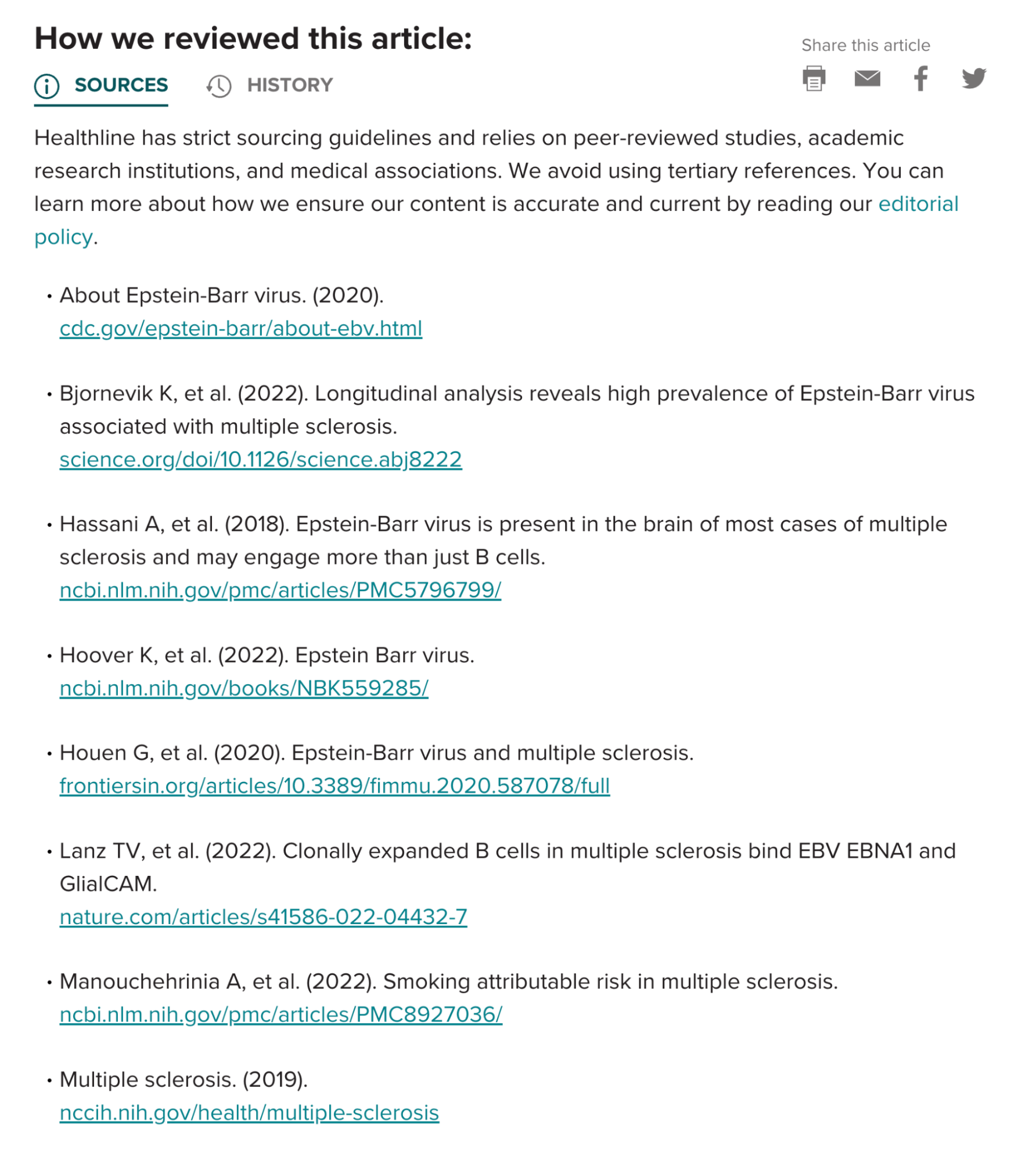
Keeping the history of edits and reviews
Health is one of those niches where almost no content can be considered evergreen. New research can sometimes even flip existing findings and best practices around.
Next to the Sources tab, Healthline also shows the History tab where we can see who has done what with the content and when:

Anthony Machi from Healthline’s SEO team said that they already had a 50:50 split for publishing new and updating old content back in 2022.
I can imagine that they already spend more time on the updates now. The number of new pieces published is significantly down recently when looking at the past five years:
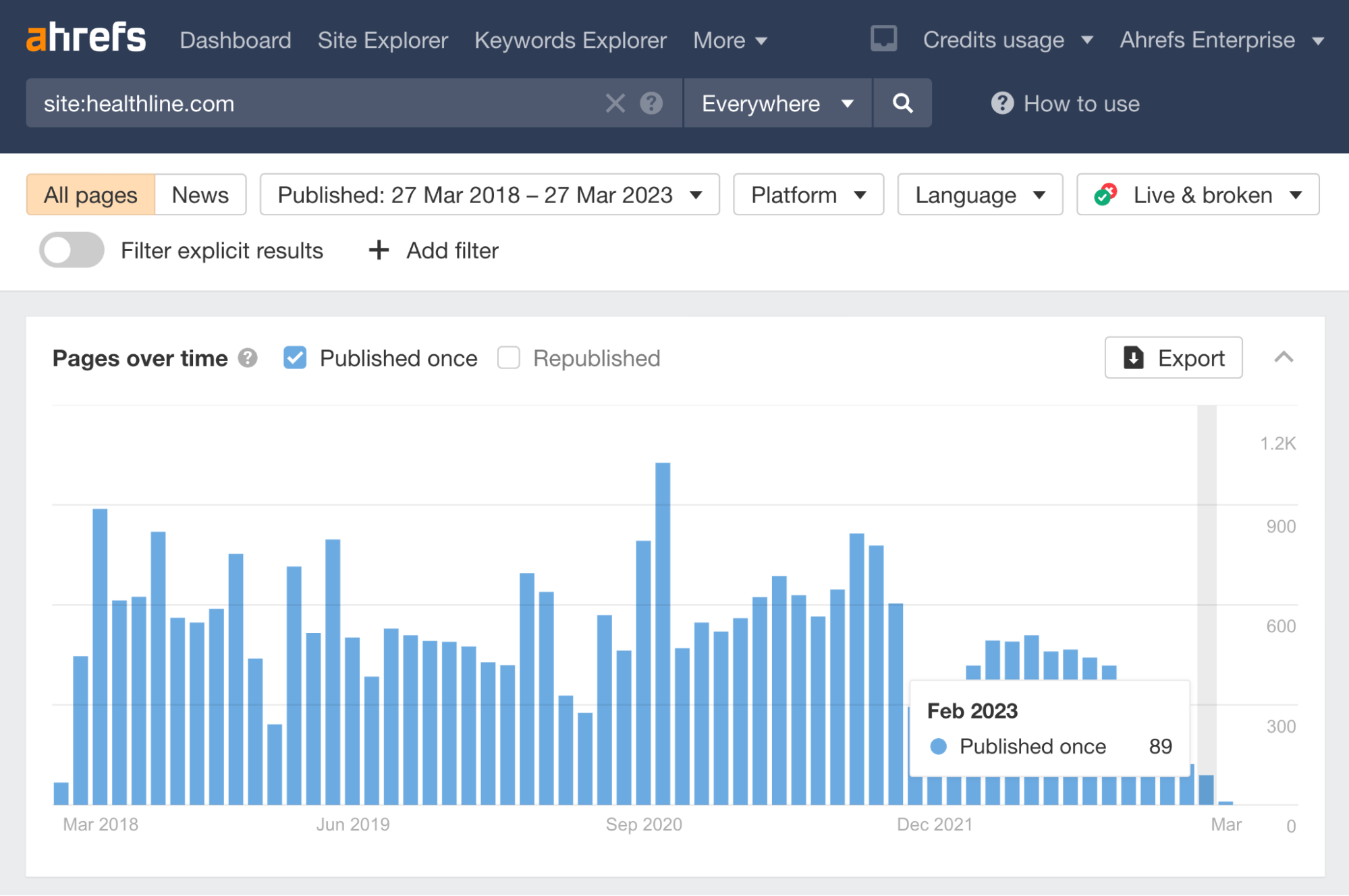
Final thoughts
Even though I spent many hours analyzing Healthline’s website from all sorts of angles, I’m sure there are many interesting SEO insights I still haven’t uncovered.
It’s a website anyone can take inspiration from to improve their own SEO and content game regardless of the niche they’re in.
Got any questions or comments? Let me know on Twitter.
SEO
Measuring Content Impact Across The Customer Journey

Understanding the impact of your content at every touchpoint of the customer journey is essential – but that’s easier said than done. From attracting potential leads to nurturing them into loyal customers, there are many touchpoints to look into.
So how do you identify and take advantage of these opportunities for growth?
Watch this on-demand webinar and learn a comprehensive approach for measuring the value of your content initiatives, so you can optimize resource allocation for maximum impact.
You’ll learn:
- Fresh methods for measuring your content’s impact.
- Fascinating insights using first-touch attribution, and how it differs from the usual last-touch perspective.
- Ways to persuade decision-makers to invest in more content by showcasing its value convincingly.
With Bill Franklin and Oliver Tani of DAC Group, we unravel the nuances of attribution modeling, emphasizing the significance of layering first-touch and last-touch attribution within your measurement strategy.
Check out these insights to help you craft compelling content tailored to each stage, using an approach rooted in first-hand experience to ensure your content resonates.
Whether you’re a seasoned marketer or new to content measurement, this webinar promises valuable insights and actionable tactics to elevate your SEO game and optimize your content initiatives for success.
View the slides below or check out the full webinar for all the details.
SEO
How to Find and Use Competitor Keywords

Competitor keywords are the keywords your rivals rank for in Google’s search results. They may rank organically or pay for Google Ads to rank in the paid results.
Knowing your competitors’ keywords is the easiest form of keyword research. If your competitors rank for or target particular keywords, it might be worth it for you to target them, too.
There is no way to see your competitors’ keywords without a tool like Ahrefs, which has a database of keywords and the sites that rank for them. As far as we know, Ahrefs has the biggest database of these keywords.
How to find all the keywords your competitor ranks for
- Go to Ahrefs’ Site Explorer
- Enter your competitor’s domain
- Go to the Organic keywords report
The report is sorted by traffic to show you the keywords sending your competitor the most visits. For example, Mailchimp gets most of its organic traffic from the keyword “mailchimp.”


Since you’re unlikely to rank for your competitor’s brand, you might want to exclude branded keywords from the report. You can do this by adding a Keyword > Doesn’t contain filter. In this example, we’ll filter out keywords containing “mailchimp” or any potential misspellings:


If you’re a new brand competing with one that’s established, you might also want to look for popular low-difficulty keywords. You can do this by setting the Volume filter to a minimum of 500 and the KD filter to a maximum of 10.


How to find keywords your competitor ranks for, but you don’t
- Go to Competitive Analysis
- Enter your domain in the This target doesn’t rank for section
- Enter your competitor’s domain in the But these competitors do section


Hit “Show keyword opportunities,” and you’ll see all the keywords your competitor ranks for, but you don’t.


You can also add a Volume and KD filter to find popular, low-difficulty keywords in this report.


How to find keywords multiple competitors rank for, but you don’t
- Go to Competitive Analysis
- Enter your domain in the This target doesn’t rank for section
- Enter the domains of multiple competitors in the But these competitors do section


You’ll see all the keywords that at least one of these competitors ranks for, but you don’t.


You can also narrow the list down to keywords that all competitors rank for. Click on the Competitors’ positions filter and choose All 3 competitors:


- Go to Ahrefs’ Site Explorer
- Enter your competitor’s domain
- Go to the Paid keywords report


This report shows you the keywords your competitors are targeting via Google Ads.
Since your competitor is paying for traffic from these keywords, it may indicate that they’re profitable for them—and could be for you, too.
You know what keywords your competitors are ranking for or bidding on. But what do you do with them? There are basically three options.
1. Create pages to target these keywords
You can only rank for keywords if you have content about them. So, the most straightforward thing you can do for competitors’ keywords you want to rank for is to create pages to target them.
However, before you do this, it’s worth clustering your competitor’s keywords by Parent Topic. This will group keywords that mean the same or similar things so you can target them all with one page.
Here’s how to do that:
- Export your competitor’s keywords, either from the Organic Keywords or Content Gap report
- Paste them into Keywords Explorer
- Click the “Clusters by Parent Topic” tab


For example, MailChimp ranks for keywords like “what is digital marketing” and “digital marketing definition.” These and many others get clustered under the Parent Topic of “digital marketing” because people searching for them are all looking for the same thing: a definition of digital marketing. You only need to create one page to potentially rank for all these keywords.


2. Optimize existing content by filling subtopics
You don’t always need to create new content to rank for competitors’ keywords. Sometimes, you can optimize the content you already have to rank for them.
How do you know which keywords you can do this for? Try this:
- Export your competitor’s keywords
- Paste them into Keywords Explorer
- Click the “Clusters by Parent Topic” tab
- Look for Parent Topics you already have content about
For example, if we analyze our competitor, we can see that seven keywords they rank for fall under the Parent Topic of “press release template.”


If we search our site, we see that we already have a page about this topic.


If we click the caret and check the keywords in the cluster, we see keywords like “press release example” and “press release format.”


To rank for the keywords in the cluster, we can probably optimize the page we already have by adding sections about the subtopics of “press release examples” and “press release format.”
3. Target these keywords with Google Ads
Paid keywords are the simplest—look through the report and see if there are any relevant keywords you might want to target, too.
For example, Mailchimp is bidding for the keyword “how to create a newsletter.”


If you’re ConvertKit, you may also want to target this keyword since it’s relevant.
If you decide to target the same keyword via Google Ads, you can hover over the magnifying glass to see the ads your competitor is using.


You can also see the landing page your competitor directs ad traffic to under the URL column.


Learn more
Check out more tutorials on how to do competitor keyword analysis:
SEO
Google Confirms Links Are Not That Important

Google’s Gary Illyes confirmed at a recent search marketing conference that Google needs very few links, adding to the growing body of evidence that publishers need to focus on other factors. Gary tweeted confirmation that he indeed say those words.
Background Of Links For Ranking
Links were discovered in the late 1990’s to be a good signal for search engines to use for validating how authoritative a website is and then Google discovered soon after that anchor text could be used to provide semantic signals about what a webpage was about.
One of the most important research papers was Authoritative Sources in a Hyperlinked Environment by Jon M. Kleinberg, published around 1998 (link to research paper at the end of the article). The main discovery of this research paper is that there is too many web pages and there was no objective way to filter search results for quality in order to rank web pages for a subjective idea of relevance.
The author of the research paper discovered that links could be used as an objective filter for authoritativeness.
Kleinberg wrote:
“To provide effective search methods under these conditions, one needs a way to filter, from among a huge collection of relevant pages, a small set of the most “authoritative” or ‘definitive’ ones.”
This is the most influential research paper on links because it kick-started more research on ways to use links beyond as an authority metric but as a subjective metric for relevance.
Objective is something factual. Subjective is something that’s closer to an opinion. The founders of Google discovered how to use the subjective opinions of the Internet as a relevance metric for what to rank in the search results.
What Larry Page and Sergey Brin discovered and shared in their research paper (The Anatomy of a Large-Scale Hypertextual Web Search Engine – link at end of this article) was that it was possible to harness the power of anchor text to determine the subjective opinion of relevance from actual humans. It was essentially crowdsourcing the opinions of millions of website expressed through the link structure between each webpage.
What Did Gary Illyes Say About Links In 2024?
At a recent search conference in Bulgaria, Google’s Gary Illyes made a comment about how Google doesn’t really need that many links and how Google has made links less important.
Patrick Stox tweeted about what he heard at the search conference:
” ‘We need very few links to rank pages… Over the years we’ve made links less important.’ @methode #serpconf2024″
Google’s Gary Illyes tweeted a confirmation of that statement:
“I shouldn’t have said that… I definitely shouldn’t have said that”
Why Links Matter Less
The initial state of anchor text when Google first used links for ranking purposes was absolutely non-spammy, which is why it was so useful. Hyperlinks were primarily used as a way to send traffic from one website to another website.
But by 2004 or 2005 Google was using statistical analysis to detect manipulated links, then around 2004 “powered-by” links in website footers stopped passing anchor text value, and by 2006 links close to the words “advertising” stopped passing link value, links from directories stopped passing ranking value and by 2012 Google deployed a massive link algorithm called Penguin that destroyed the rankings of likely millions of websites, many of which were using guest posting.
The link signal eventually became so bad that Google decided in 2019 to selectively use nofollow links for ranking purposes. Google’s Gary Illyes confirmed that the change to nofollow was made because of the link signal.
Google Explicitly Confirms That Links Matter Less
In 2023 Google’s Gary Illyes shared at a PubCon Austin that links were not even in the top 3 of ranking factors. Then in March 2024, coinciding with the March 2024 Core Algorithm Update, Google updated their spam policies documentation to downplay the importance of links for ranking purposes.
The documentation previously said:
“Google uses links as an important factor in determining the relevancy of web pages.”
The update to the documentation that mentioned links was updated to remove the word important.
Links are not just listed as just another factor:
“Google uses links as a factor in determining the relevancy of web pages.”
At the beginning of April Google’s John Mueller advised that there are more useful SEO activities to engage on than links.
Mueller explained:
“There are more important things for websites nowadays, and over-focusing on links will often result in you wasting your time doing things that don’t make your website better overall”
Finally, Gary Illyes explicitly said that Google needs very few links to rank webpages and confirmed it.
I shouldn’t have said that… I definitely shouldn’t have said that
— Gary 鯨理/경리 Illyes (so official, trust me) (@methode) April 19, 2024
Why Google Doesn’t Need Links
The reason why Google doesn’t need many links is likely because of the extent of AI and natural language undertanding that Google uses in their algorithms. Google must be highly confident in its algorithm to be able to explicitly say that they don’t need it.
Way back when Google implemented the nofollow into the algorithm there were many link builders who sold comment spam links who continued to lie that comment spam still worked. As someone who started link building at the very beginning of modern SEO (I was the moderator of the link building forum at the #1 SEO forum of that time), I can say with confidence that links have stopped playing much of a role in rankings beginning several years ago, which is why I stopped about five or six years ago.
Read the research papers
Authoritative Sources in a Hyperlinked Environment – Jon M. Kleinberg (PDF)
The Anatomy of a Large-Scale Hypertextual Web Search Engine
Featured Image by Shutterstock/RYO Alexandre
-

 PPC5 days ago
PPC5 days ago19 Best SEO Tools in 2024 (For Every Use Case)
-

 MARKETING6 days ago
MARKETING6 days agoStreamlining Processes for Increased Efficiency and Results
-
SEARCHENGINES6 days ago
Daily Search Forum Recap: April 17, 2024
-

 SEO6 days ago
SEO6 days agoAn In-Depth Guide And Best Practices For Mobile SEO
-

 PPC6 days ago
PPC6 days ago97 Marvelous May Content Ideas for Blog Posts, Videos, & More
-

 MARKETING5 days ago
MARKETING5 days agoEcommerce evolution: Blurring the lines between B2B and B2C
-
SEARCHENGINES5 days ago
Daily Search Forum Recap: April 18, 2024
-
SEARCHENGINES4 days ago
Daily Search Forum Recap: April 19, 2024















